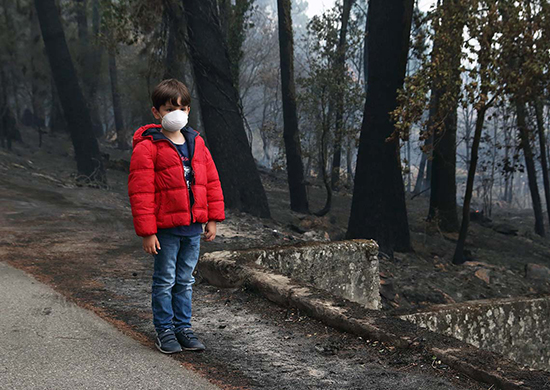Featured Resources are highlights of resources developed by the Task Force or its Subcommittees or by federal departments, agencies, or other interagency efforts that are relevant to addressing children’s environmental health risks and safety risks. Featured Resources may occasionally include items developed by non-governmental organizations in partnership or with significant support of federal agencies. The validity of the information in any Featured Resource is the responsibility of the developer. Inclusion as a Featured Resource does not imply any priority status but is meant to showcase the broad range of resources available and being developed by the federal government in Task Force priority areas.
Wildfires and Children's Health Resources
January 2025
Wildfires can impact populations, including children, in many ways. Understanding the risks and health effects of wildfires, having up-to-date status of wildfire exposure and air quality, and outlining actions that can help to decrease the impact of these events can help families and communities protect their health.
The Subcommittee on Children in Emergencies and Disasters of the President’s Task Force on Environmental Health Risks and Safety Risks to Children has compiled this list of publicly available wildfire and health resources to assist families and communities in protecting children’s health during and after such events.
Resources for Children
- Children and Disasters provides information about how children and adolescents experience disasters and ways parents and caregivers can help young people cope and develop resilience.
- How to Talk With Kids About Tragedies & Other Traumatic News Events from the American Academy of Pediatrics provides information for parents and caregivers to share strategies to talk to children after disaster events.
- Protecting Children From Wildfire Smoke and Ash provides a list of clear actions families can take to safeguard children compiled by the EPA and partners.
- Wildfire Resources provides information from the National Child Traumatic Stress Network on the trauma of wildfires and how to protect children before, during and after these events.
- Wildfire Smoke and Children provides information from the CDC to prepare for wildfire season, and what to do during and after a wildfire event.
- Wildfires offers a guidance for families, communities and health professionals to help prepare for, respond to and recover from wildfires from the Pediatric Environmental Health Specialty Units.
- Wildfires provides resources from the Western States Pediatric Environmental Health Specialty Unity (PEHSU) on wildfire smoke and children, including infographics, informational documents, and videos in English and Spanish.
- Why Is Coco Red? is a colorful free picture book to help children learn about wildfire smoke and air quality. It is available in English and Spanish with an accompanying 6-minute YouTube video.
Resources for Healthcare Professionals
- Psychological First Aid (PFA) and Skills for Psychological Recovery (SPR) provides information and resources from the National Child Traumatic Stress Network for behavioral health response and recovery practices for survivors of disasters, including wildfires.
- Wildfire Smoke and Your Patients' Health is a course intended for physicians, registered nurses, asthma educators and others involved in clinical or health education.
- Wildfires provides recommendations for healthcare providers on wildfires and children from the American Academy of Pediatrics.
General Resources
- After a Fire website contains infographics and information on safeguarding children’ and families’ health when returning home after a fire. It is available in English and Spanish.
- Air Now, Wildfires highlights air quality in your local area and provides air quality information at the state and national level. An interactive map lets users view large scale or more granular air quality data.
- Create a Clean Room To Protect Indoor Air Quality During a Wildfire provides instructions from the EPA on how to set up a room in your house or other building to keep levels of smoke and other particles as low as possible during wildfire smoke events. It is available in multiple languages.
- Smoke-Ready Toolbox for Wildfires from EPA provides an extensive list of information, publications, training information and other resources related to wildfires.
- Wildfire Outlook from HHS informs national wildfire potential outlook and health effects.
California Wildfires Information
What DHS and FEMA Are Doing. FEMA has established a landing page on FEMA.gov with the latest information from FEMA and the Department of Homeland Security (DHS) on the disaster.
What the U.S. Government Is Doing. The General Services Administration (GSA) has created a landing page on USA.gov for government-wide information related to the California wildfire activities.

